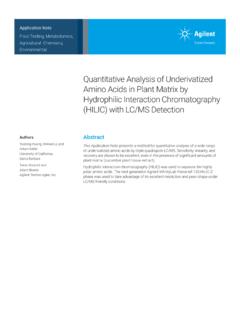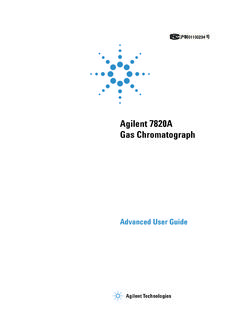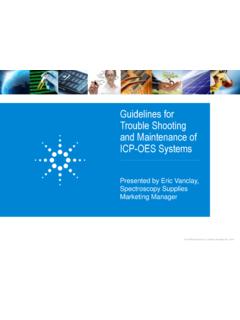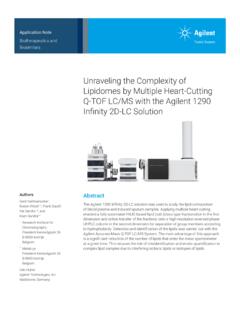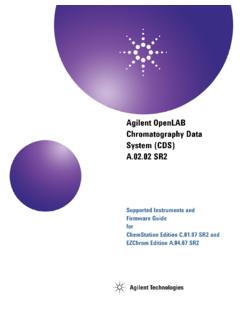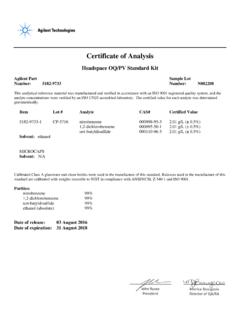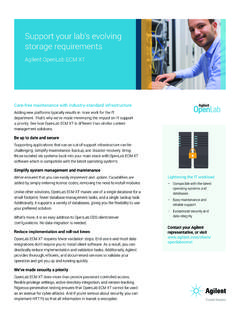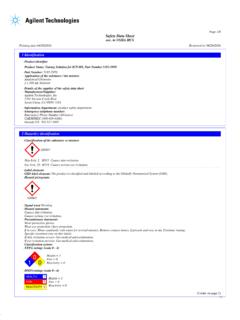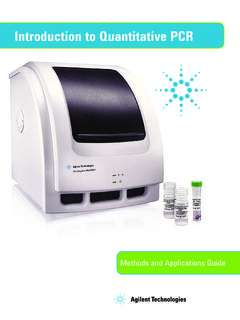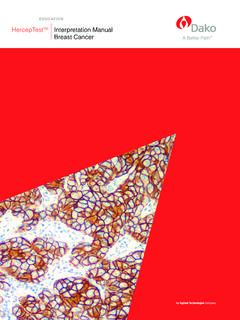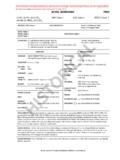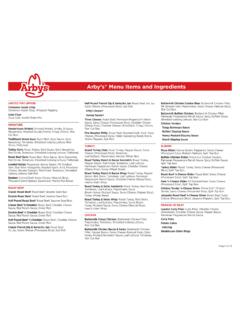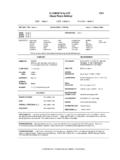Transcription of Methods for the Analysis of Underivatized Amino Acids by …
1 Application Note Food Testing, Metabolomics Methods for the Analysis of Underivatized Amino Acids by LC/MS. For Food, Life Science, and Metabolomics Applications Authors Abstract Andrew Kennedy and This Application Note presents a method optimized for the Analysis of Adam Bivens Underivatized Amino Acids . The polar nature of Amino Acids makes Analysis by reversed-phase liquid chromatography challenging. Conversely, Hydrophilic Interaction Chromatography (HILIC) is capable of retaining and separating complex Amino acid mixtures, while offering a similar workflow to traditional reversed-phase chromatography. The combination of HILIC with mass spectrometry offers a simple and powerful solution for Amino acid Analysis . Introduction Eppendorf pipettes and repeater Sample Preparation Vortexer and multitube vortexers The Amino acid standards were mixed Separation of Underivatized Amino to the concentrations listed in Table 1. (VWR, Radnor, PA, USA). Acids using Hydrophilic Interaction in water, and analyzed with no further Chromatography (HILIC) at low pH with HDPE solvent bottles (VWR, Radnor, sample preparation.)
2 Positive mode LC/MS detection was PA, USA). found to give the best overall sensitivity Mobile Phase Preparation Instrumentation and chromatographic performance. A 200 mM ammonium formate stock Agilent 1290 Infinity II binary pump The Agilent InfinityLab Poroshell was made in water, and adjusted to pH 3. (G7120A). 120 m HILIC-Z and HILIC-OH5 with formic acid . Mobile phase A was chemistries offer two excellent options Agilent 1290 Infinity II vialsampler made by diluting the stock solution 9:1. for LC/MS of Amino Acids . Both give (G7129B) in water. Mobile phase B was made by complete separation of the challenging Agilent 1290 Infinity II multicolumn diluting the stock solution 9:1 in ACN. leucine/isoleucine isobars, and fully thermostat (G7116B) The final concentration in both mobile resolve a wide range of Amino Acids . phases was 20 mM of ammonium Ultralow dispersion kit for formate. Agilent 1290 Infinity LC Series Experimental (5067 5189) Extended exposure of the mobile phases to glassware was found to introduce Reagents and Chemicals Agilent MassHunter workstation ionic species that interfere with and All reagents were HPLC grade or higher.
3 Software suppress MS detection. Mobile phases Ultra LC/MS grade acetonitrile was Agilent 6470 triple quadrupole stored in glass should be changed bought from Baker (Center Valley, LC/MS regularly, or the glass bottles should be PA, ). Water was purified using an Agilent Jet Stream Electrospray replaced with HDPE bottles. EMD Millipore Milli-Q Integral System ionization source (Darmstadt, Germany). Reagent-grade formic acid (FA) (p/n G2453-85060) was Instrument Conditions from Agilent Technologies. Ammonium formate, ammonium acetate, ammonium Parameter Value hydroxide, and Amino acid standards HPLC. were purchased from Sigma-Aldrich Agilent InfinityLab Poroshell 120 HILIC-Z, 100 mm (St. Louis, MO, USA). Amino Acids were Column Agilent InfinityLab Poroshell 120 HILIC-OH5, 100 mm stored at 70 C until day of use. Mobile phase A 10 % (200 mM ammonium formate in water at pH = 3), 90 % water Equipment and Materials Mobile phase B 10 % (200 mM ammonium formate in water at pH = 3), 90 % acetonitrile Agilent InfinityLab Fittings Flow rate mL/min Column temperature 30 C.
4 Column front: InfinityLab Injection volume L. Quick Connect LC fitting Total run time 16 minutes (p/n 5067 5965). Time (min) %B. Column back: InfinityLab Quick Gradient 0 100. 10 70. Turn LC fitting (p/n 5067-5966) 11 100. Agilent vial, screw top, amber, MS. write on spot, certified, 2 mL Ionization mode ESI Positive (p/n 5182-0716) Gas temperature 300 C. Gas flow L/min Agilent bonded screw cap, PTFE/red Nebulizer 45 psi silicone septa (p/n 5190-7024). Sheath gas temperature 400 C. Agilent vial insert, 250 L, Sheath gas flow 11 L/min deactivated glass with polymer feet Capillary voltage 3,500 V. (p/n 5181-8872) Nozzle voltage 0V. 2. Table 1. Amino acid standard concentration, retention, and dMRM values. Agilent InfinityLab Agilent InfinityLab Concentration Poroshell 120 Poroshell 120 Precursor ion Product ion Fragmentor Collision Dwell time Analyte (mM) HILIC-Z RT (min) HILIC OH5 RT (min) (m/z) (m/z) (V) energy (V) (ms). Phenylalanine 25 5 10. Leucine 25 8 10. Isoleucine 25 8 10.
5 Methionine 75 8 10. Tyrosine 25 12 10. Valine 25 8 10. Proline 50 16 10. Alanine 25 8 10. Threonine 25 10 10. Glycine 25 5 10. Serine 25 8 10. Glutamic acid 75 16 10. Aspartic acid 50 15 10. Histidine 25 12 10. Arginine 75 28 10. Lysine 50 16 10. Note: All transitions used a cell accelerator voltage = 4. Results Acquisition time (min). Figure 1. Separation of Amino Acids using the Agilent InfinityLab Poroshell 120 HILIC-Z column. Leucine/isoleucine selectivity 3. Conclusions Amino Acids were successfully analyzed by positive mode LC/MS. using HILIC. The Agilent InfinityLab Poroshell HILIC-Z showed better overall peak shape, especially for more basic compounds like aspartic acid and histidine. The Agilent InfinityLab Poroshell HILIC-OH5 showed better resolution of early eluting peaks, such as tyrosine, valine, and proline. The normally challenging leucine/isoleucine isobars were baseline separated by both columns. Acquisition time (min). Figure 2. Separation of Amino Acids using the Agilent InfinityLab Poroshell 120 HILIC-OH5 column.
6 Leucine/isoleucine selectivity This information is subject to change without notice. Agilent Technologies, Inc. 2017. Printed in the USA, December 1, 2017. 5991-8582EN.
